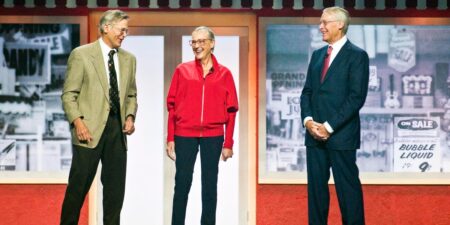Jackson Hole is having its annual moment in the economic limelight — and Federal Reserve Chair Jerome Powell didn’t disappoint.
At the central bank’s policy symposium, Powell spoke about the job market, monetary policy, and the Fed’s plan for the future. He left the door open for a rate cut in the Fed’s highly-anticipated September meeting, sending markets surging.
“Our policy rate is now 100 basis points closer to neutral than it was a year ago, and the stability of the unemployment rate and other labor market measures allows us to proceed carefully as we consider changes to our policy stance,” Powell told the crowd of policymakers, economists, and reporters gathered in Wyoming. “Nonetheless, with policy in restrictive territory, the baseline outlook and the shifting balance of risks may warrant adjusting our policy stance.”
Powell’s keynote remarks emphasized America’s “uncertain” economic position. The Fed is tasked with keeping the labor market stable and inflation under control, dual goals that have become increasingly at odds in 2025. The central bank’s latest decisions are also a source of political tension, with the Trump Administration critiquing Powell’s ongoing plan to keep rates steady. His Jackson Hole speech sets the tone for the remainder of the year.
The speech was also Powell’s last as Fed chair, as he is set to exit the role in May 2026.
The Fed has kept rates steady so far this year
As Powell put it, “monetary policy is not on a preset course,” though current employment and inflation data could warrant a Fed “policy change.”
Per FOMC Fed Watch, market participants expect the central bank has a 69.6% chance of cutting rates next month, which would be the first move this year. The Fed has penciled in two rate cuts in 2025, though this estimate could change based on economic conditions. Powell has repeatedly emphasized that he is waiting to see the full impact of President Donald Trump’s tariff agenda to make a call.
The July decision to keep rates steady was divisive among Fed members. Two governors, Michelle Bowman and Christopher Waller, dissented. Bowman sees “inflation moving considerably closer to the Committee’s objective, after excluding temporary effects of tariffs, a labor market near full employment but with signs of less dynamism, and slowing economic growth this year,” according to minutes from the meeting.
Last month’s meeting also came days before a worse-than-expected jobs report. The US economy added 73,000 jobs in July, missing the expected 106,000, and revisions showed that there were far fewer jobs created in May and June than initially reported. While revisions are a normal part of the Bureau or Labor Statistics’ data collection process, the agency said the latest revisions were steeper than expected. Unemployment has creeped up slightly, though remains historically low. And job vacancies are limited, signaling that companies are hesitant to hire and employees aren’t keen to leave their current role.
“While the labor market appears to be in balance, it is a curious kind of balance that results from a marked slowing in both the supply of and demand for workers,” Powell said Friday. He added that there’s a risk of rising layoff rates and rising unemployment in the coming months.
Meanwhile, inflation has been hovering above the Fed’s 2% goal. A fall rate cut would make borrowing costs cheaper and stimulate the economy, but stands the risk of increasing inflation. Other indicators of economic health are mixed: Retail spending is making a small recovery from early summer dips, and GDP rose last quarter, mitigating a decline in the first quarter of the year. Inflation held steady at 2.7% in July, but is up from 2.4% in May: “We cannot take the stability of inflation expectations for granted,” Powell said. Consumer sentiment slid a few points in August.
“The economy has faced new challenges. Significantly higher tariffs across our trading partners are remaking the global trading system. Tighter immigration policy has led to an abrupt slowdown in labor force growth,” Powell said, adding “There is significant uncertainty about where all of these polices will eventually settle and what their lasting effects on the economy will be.”
Jackson Hole sets the tone for future monetary policy
Ahead of Jackson Hole, the White House has been keeping Powell in the hot seat.
On several occasions, Trump has suggested firing Powell before the end of his term — a move that investors and economists say would send markets into chaos. The president has dubbed Powell with the moniker, “Too Late,” as he pressures the Fed chair to cut rates.
Trump will nominate Powell’s successor. And, because Governor Adrianna Krugler plans to step down, the president will have an opportunity to fill a seat on the Fed Committee that votes on rate moves. He is also calling on another Fed member, Lisa Cook, to resign.
For American consumers, the Fed’s end-of-year monetary policy will trickle down to impact mortgage rates, auto loans, credit card borrowing, and more. But some economists have said lower rates would have little tangible impact on the housing market.
Powell made no promises, but hinted at a shifting Fed policy strategy, which could be good news for borrowers.
“The US economy has shown resilience in a context of sweeping changes in economic policy,” he said.
Read the full article here
















